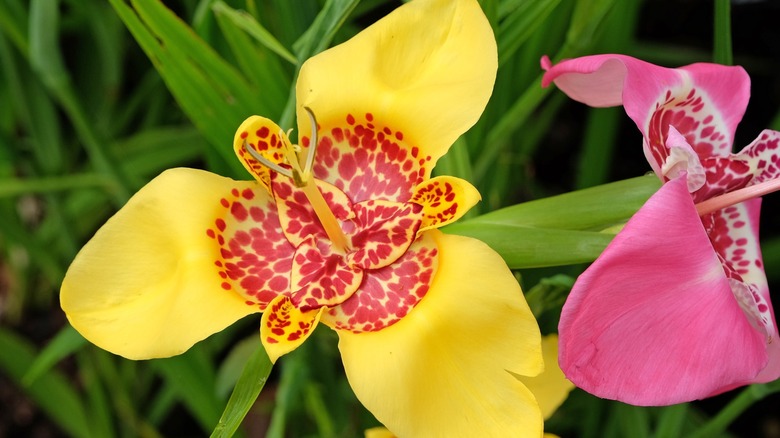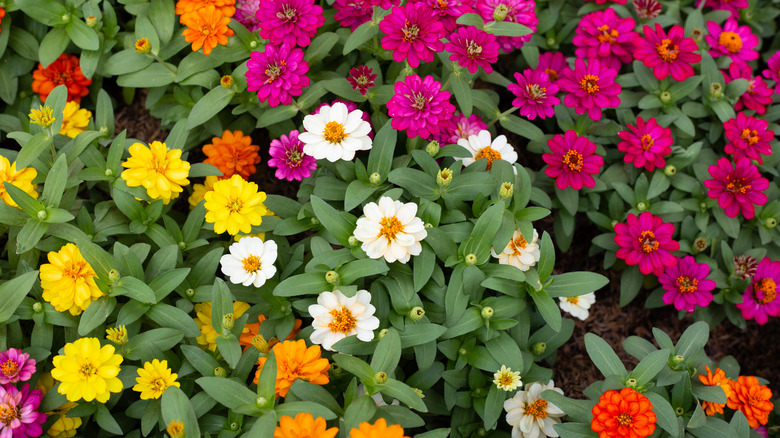The Rare Yellow Flower No One Else Will Have In Their Garden
When choosing which flowering annuals to plant that will last all summer, it's tempting to fall back on tried-and-true picks — you know, the kind you see all around your neighborhood without fail year after year. Consider mixing things up by planting a rare flower, such as the Mexican shell flower (Tigridia pavonia), also known as the tiger flower or peacock flower. Between its lush leaves and distinctive blooms, this tall grower is an unconventional but easy-to-plant option that will instantly glam up your garden (and have you fielding questions from your neighbors as to where you got it).
"Its unusual-looking flowers come in vibrant colors with three large outer petals that surround a speckled center and a long showy stamen for an eye-catching display," master gardener Janet Loughrey said in an article for Martha Stewart. The Mexican shell flower comes from the same family of plants as irises (Iridacae). Though it's a perennial, it grows well as an annual in USDA Hardiness Zones 2 through 7 and comes in colors such as yellow, red, orange, pink, and white. As the name suggests, Mexican shell flowers are native to Mexico and some countries in Central and South America; however, they are not considered invasive in the United States. As an added bonus, this plant is naturally resistant to deer and rabbits and attracts pollinators.
How to grow and care for Mexican shell flowers
Since Mexican shell flowers bloom in the summer, you'll want to plant them in the spring. It thrives in full sun and rich, well-drained soil. However, being a drought-tolerant plant, it can get fussy when over-watered or exposed to heavy rainfall. Try to choose a spot that gets plenty of light, whether that's a sun-drenched patch in your garden or yard, or a pot that you can move around and take inside when a summer storm hits. This is definitely one of the most stunning plants that will thrive in a full-sun container. For the record, you can grow Mexican shell flowers in a wider range of USDA Hardiness Zones if you plan to bring it indoors. Space each bulb out roughly 4 to 5 inches apart and 2 to 3 inches deep in the soil.
Grouped together, a handful's worth of bulbs will look substantial and pair well with daintier flowers or more dense, non-flowering plants. Fertilize them a few times prior to blooming. After those beautiful flowers appear, water them regularly, keeping the soil somewhat moist. Come fall, you'll notice that your Mexican shell flowers are beginning to die. If they were planted outside, simply cut back any excess growth and let nature do its thing; if you opted for pots, however, you can bring them inside when the temperatures start to drop to prolong their blooms. Once relocated, you'll be able to enjoy Mexican shell flower's pretty blooms well into the winter.
Other flowers you can pair with Mexican shell flowers
Looking to surround your Mexican shell flowers with other flowering plants? Lucky for you, there are a number of pretty picks that pair well with these exotic blooms. Sun-loving zinnias (Zinnia elegans), a mainstay for many gardeners, are one solid option. Also native to Mexico, they fare well in the same conditions as Mexican shell flowers and boast splashy, bright-colored blossoms. They're bushier, shorter in height, and bloom slightly longer into fall — paired together, zinnias and Mexican shell flowers will keep your garden looking lush and densely covered in blossoms.
You can even cut them to decorate your home with flowers from your garden. For a less-showy alternative, try a more delicate, low-growing flower. Perennials that favor similar growing conditions, such as lavender (Lavandula angustifolia), would work well. Since they're much shorter than Mexican shell flowers, they'll make an attractive companion plant that doesn't compete with it for light or aesthetic appeal.


